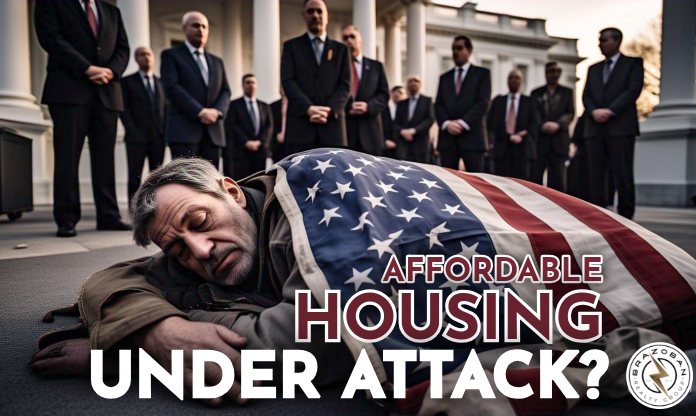As a real estate professional working with both seasoned and new investors across various strategies—from short-term vacation rentals to traditional long-term leases—I’ve been fielding numerous questions about President Donald Trump’s recently proposed federal budget and its impact on housing. In particular, the proposed cuts to the Department of Housing and Urban Development (HUD), including the potential elimination of the Section 8 voucher program, have raised significant concerns.
These are not just political talking points—they’re real issues that could affect property values, rental demand, and neighborhood dynamics for years to come. Here’s what you need to know.
The Proposal at a Glance
President Trump’s fiscal year 2026 budget proposal includes a substantial $33.6 billion cut to HUD, representing a 44% reduction from current levels. This includes a $26.7 billion decrease in rental assistance funding, effectively ending the Section 8 Housing Choice Voucher program. The plan suggests replacing these programs with state-based block grants, allowing states to design their own rental assistance initiatives. (National Association of Home Builders, Business Insider, The Washington Post)
While such proposals often undergo changes in Congress, the magnitude of these cuts signals a significant shift in federal housing policy priorities.(CalMatters)

Why This Matters to Investors
1. Impact on Long-Term Rental Demand
For landlords in lower-income neighborhoods who currently participate in the Section 8 program, this could be a game changer. Many property owners rely on the program’s guaranteed rent payments. Eliminating that safety net could mean increased vacancy rates and financial instability for landlords who cater to this tenant base.
Even if you’re not accepting vouchers now, demand dynamics could shift. Without subsidies, many tenants might be forced to move to more affordable or overcrowded housing—or exit the rental market entirely. That would lead to increased supply and potentially declining rents in certain areas.
2. Changes in Risk Profile
One of the biggest advantages of renting to Section 8 tenants is the consistent, government-backed rental payments. Removing that source of stability increases the default risk associated with lower-income tenants. This might make investors more hesitant to buy or hold properties in low- to moderate-income neighborhoods.
3. Neighborhood Gentrification and Displacement
While some investors might see opportunity in a post-Section 8 world—namely, by repositioning assets and targeting higher-income tenants—there are ethical and logistical challenges. Displacement of long-term residents can create social backlash and community resistance, which can affect everything from leasing velocity to property crime rates.
4. Short-Term Rental Shifts
Investors in short-term rentals (STRs) may not feel the direct effects, but the ripple effects matter. As long-term affordability issues increase, municipalities could impose stricter STR regulations to preserve housing stock. We’ve already seen this happen in cities like New York and Los Angeles.
Additionally, areas that previously had stable long-term rental demand might become riskier investments, leading some investors to pivot to STRs, which could further saturate the market and reduce profitability.

A Few Silver Linings (for Some)
While there are real concerns, some savvy investors may find opportunity amid the disruption:
- Repositioning Strategy: If voucher holders are displaced, there may be a temporary dip in property prices in affected areas. Investors with the capital and time to wait could buy low and invest in value-add renovations to attract different tenant profiles.
- Private Subsidies or Local Programs: Cities and states might step in with their own programs to fill the gap left by HUD. Smart investors will keep an eye on local developments and look for new incentive programs.(The Inspection Group)
The Big Picture: A Housing Market in Transition
No matter your political stance, the potential elimination of Section 8 and sweeping HUD cuts would represent a seismic shift in the U.S. housing landscape. The private market may not be equipped to fill the void. This puts the onus on investors to be nimble, well-informed, and proactive in adapting their strategies.
Personally, I encourage all my investor clients—especially those in the affordable housing space—to revisit their risk assessments and stress-test their portfolios under different policy scenarios. The days of “business as usual” may be behind us.
Final Thoughts
We’re in a moment where housing policy and investment strategy are more intertwined than ever. Staying informed isn’t just smart—it’s essential. While Trump’s proposed cuts are far from guaranteed, they shine a light on an ongoing debate about the role of government in housing—and where the responsibility truly lies.(en.wikipedia.org)
If you want to stay ahead of policy changes, market trends, and strategies tailored for short-term and long-term rental investors, sign up for our weekly newsletter. We break down the headlines and explain what they really mean for your bottom line—every Friday.
Click here to subscribe and get the insights you need to stay profitable and prepared.
References
- Salmonsen, M. (2025, May 12). Trump proposes cutting $33B in HUD funding, including Section 8. Multifamily Dive. (Multifamily Dive)
- Raji, T. (2025, May 6). Proposed cuts to housing programs could affect millions, experts warn. The Washington Post. (The Washington Post)
- NPR. (2025, May 2). Trump budget would slash federal rental aid by 40%. (NPR)
- BiggerPockets. (2025, May 8). Trump’s Proposed HUD Cuts and Section 8 Elimination. (BiggerPockets)
- Business Insider. (2025, May 10). These boomers rely on housing vouchers to stay out of homelessness. Trump is proposing big cuts. (Business Insider)
- Vox. (2025, May 12). Trump is hoping to quietly gut the social safety net. (Vox)
- CalMatters. (2025, May 5). ‘Millions out on the street virtually overnight’: How Trump’s budget proposal could affect California. (CalMatters)




